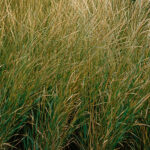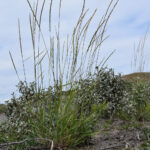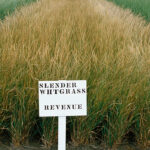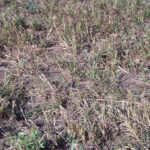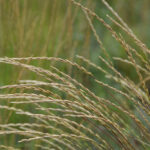Slender Wheatgrass
Elymus trachycaulus ssp. trachycaulus
General Description
Slender wheatgrass is a cool season, native perennial bunchgrass. Its roots are fibrous, sometimes with short rhizomes. Awned wheatgrass is considered a subspecies of slender wheatgrass. Slender wheatgrass (awnless) was propagated for seed production by the 1920s on the prairies and was known as western ryegrass. It was an important forage species until the introduction of crested wheatgrass in the 1930s. Stems typically range from 30 to 120 cm (12 to 47 in). Leaves are usually flat, medium green. Seed heads are slender and 8 to 20 cm (3 to 8 in) long with overlapping spikelets. Slender wheatgrass is widely adapted to moderately moist to dry grasslands, meadows, forest openings, rocky ridges, and slopes throughout western Canada.
Type
Native & tame grass. Long standing tame cultivars exist.
Origin
Native to North America.
Longevity
Short lived (3-4 years). Seed set every other year would increase persistence.
Use
Pasture, hay, reclamation. Often used to increase production in the first few years when establishing less vigorous species. Suitable forage for including in short crop rotations. Good choice for hay and silage when cut soon after heading. Best in single cut management systems.
Optimal Time of Use
Spring, summer. Slender wheatgrass has its main production occurring by early summer. Can be grazed as early as the 4-leaf stage. Hay slender wheatgrass soon after head emergence for the best forage quality and yield.
Recovery After Use
Recovery can occur within 60-80 days in cultivars. Slender wheatgrass is considered excellent forage but has low tolerance to heavy or repeated grazing.
Palatability/Nutritional Value
Slender wheatgrass is utilized by both livestock and wildlife. Average digestibility with crude protein ranging from 11% before heading to 9.5% at maturity. Palatability decreases once it heads and becomes stemmy and coarse.
Annual Precipitation min/max (mm)
350mm / 600mm
Drought Tolerance
Fair tolerance. Slender wheatgrass may not be able to survive dry conditions on coarser soils in the Brown soil zone.
Flooding Tolerance
Slender wheatgrass is well suited to drained low lying areas, but can stand spring flooding of 2-5 weeks.
Winter Hardiness
Good hardiness. Slender wheatgrass’ cold tolerance is similar to crested wheatgrass.
Soil Texture Preference
Slender wheatgrass prefers fine- to moderately-textured soils (clay to sandy-loams).
Erosion Control
Excellent for erosion control. Slender wheatgrass is often used in erosion control applications because it is quick to establish and has good seedling vigour. It is effective for erosion control following fire. Inclusion of longer-lived species is suggested for long-term stabilization.
Salinity Tolerance
Good salinity tolerance. It is often used for reclamation on saline soils.
Acidity Tolerance
Moderate. Tolerates soil pH levels as low as 5.6.
Alkalinity Tolerance
High tolerance.
Seeds per kg
298,000 seeds/kg (135,000 seeds/lb)
Suggested Mixtures
Slender wheatgrass is often included in seed mixes, with slower-establishing, longer-lived species like Russian or altai wildrye. Limit percentage of seed (10% or less) in mixes with longer-lived species. Mix with alfalfa or shorter-lived legumes for short duration hay mixes. In saline areas mix with smooth bromegrass, green wheatgrass, tall wheatgrass, and/or tall fescue.
Ease of Establishment
Slender wheatgrass establishes easily. “Adanac” and “Revenue” are two common Canadian varieties and were both developed in Saskatchewan by Agriculture and Agri-Food Canada. The Alberta Environmental Centre released “AEC Hillcrest” in 1994. This variety originates from the awned subspecies, and was developed for more difficult site conditions and shorter growing seasons.
Competitiveness
Slender wheatgrass is not particularly competitive and generally decreases in abundance over time. However, limit slender wheatgrass in seed mixes with slower to establish species as seedlings are aggressive.
Management Considerations
In situations where slender wheatgrass longevity is desired, rest the stand to allow for seed set and seed drop every 2-3 years to maximize persistence. Including slender wheatgrass in a mix maximizes initial forage production of a stand.
Saskatchewan Dryland Forage Species Adaptation Tool, AAFC Field Guide to Selected Native Forages, USDA Plants Database, British Columbia Rangeland Seeding Manual, Alberta Forage Manual
Slender wheatgrass (awnless) is uncommmon in most areas of the Central Interior. It can be found in native grassland communities in the Sub-Boreal Spruce zone on the north shores of Francois, Ootsa, Cheslatta and Ntalkuz lakes.
Slender wheatgrass (awnless) can be found in most all zones of the Southern Interior, but is not dominant in native grassland communities in this region. Inclusion of slender wheatgrass may be considered in dryland range or pasture seed mixes following timber harvest in wetter parts of the Interior Douglas-fir zone. Slender wheatgrass is expected to be short-lived in these applications.
Slender wheatgrass is commonly found in native grassland communities in the Peace-Liard region.
